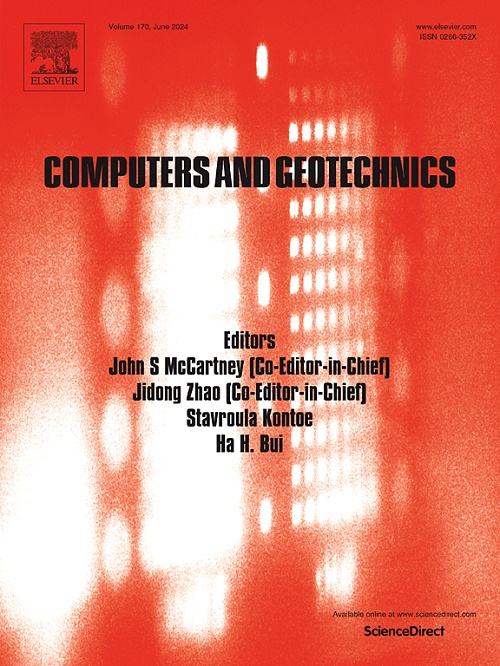基于非局部接触方法的土壤结构相互作用SPH模型
IF 5.3
1区 工程技术
Q1 COMPUTER SCIENCE, INTERDISCIPLINARY APPLICATIONS
引用次数: 0
摘要
光滑颗粒流体力学(SPH)是模拟土与结构之间相互作用的常用方法,其中接触机制是关键。传统的接触方法是利用SPH内以拉格朗日粒子为代表的不同物体最外层之间的相互作用力,本研究称之为局部策略。然而,这种策略已经被证明会引起沿界面的粒子紊乱和潜在的计算误差,这是由于众所周知的粒子缺乏导致位于界面影响域中的剩余粒子的动量不平衡造成的。为此,提出了一种非局部接触法(NLCM),在理论推导的基础上,将受边界影响的所有SPH粒子赋予合理的相互作用力,以弥补传统接触法的不足。此外,还采用了包含临界状态的发育不良模型来描述颗粒土的特性。为了验证该方法的有效性,对四个基准问题进行了仿真。砂柱静力、砂柱崩塌、平面应变压缩试验、埋管上拔等数值模拟结果与理论解或实验观测结果具有较好的一致性。最后,应用SPH模型对挡土墙土压力分布及破坏机理进行了研究。揭示了主动破坏和被动破坏过程中,土体密实度和土墙摩擦角对滑面分布和土压力的显著影响。本文章由计算机程序翻译,如有差异,请以英文原文为准。
SPH modeling of soil structure interactions using a novel non-local contact method
Smoothed Particle Hydrodynamics (SPH) is popular for modeling the interactions between soils and structures, in which the contact mechanism is crucial. The traditional contact methods apply the interplay forces between the outermost layers of different bodies represented by Lagrangian particles within SPH, referred to as local strategy in this study. However, such a strategy has been shown to induce particle disorders along the interface and potential computational errors, resulting from the momentum imbalance of the remaining particles located in the influence domain of the interface due to the well-known particle deficiency. With this regard, a non-local contact method (NLCM) is proposed to regulate the shortcomings of the traditional contact methods by assigning all SPH particles influenced by the boundary with reasonable interaction forces based on theoretical derivation. Besides, the hypoplastic model incorporating the critical state is employed to describe the granular soil’s behavior. To validate the novel method, four benchmark problems are simulated. Good consistency is found between the results from numerical simulations and theoretical solutions or experimental observations, including static sand column, sand column collapse, plane strain compression test, and buried pipe uplift. Finally, the proposed SPH model is applied to investigate the earth pressure distribution and failure mechanism of retaining walls. The significant effects of two factors, soil compactness and soil-wall friction angle, on the distribution of slip surfaces and earth pressures during active and passive failure are revealed.
求助全文
通过发布文献求助,成功后即可免费获取论文全文。
去求助
来源期刊

Computers and Geotechnics
地学-地球科学综合
CiteScore
9.10
自引率
15.10%
发文量
438
审稿时长
45 days
期刊介绍:
The use of computers is firmly established in geotechnical engineering and continues to grow rapidly in both engineering practice and academe. The development of advanced numerical techniques and constitutive modeling, in conjunction with rapid developments in computer hardware, enables problems to be tackled that were unthinkable even a few years ago. Computers and Geotechnics provides an up-to-date reference for engineers and researchers engaged in computer aided analysis and research in geotechnical engineering. The journal is intended for an expeditious dissemination of advanced computer applications across a broad range of geotechnical topics. Contributions on advances in numerical algorithms, computer implementation of new constitutive models and probabilistic methods are especially encouraged.
 求助内容:
求助内容: 应助结果提醒方式:
应助结果提醒方式:


